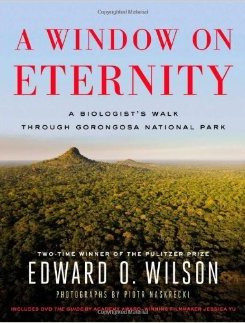An Unexplored Island in Mozambique
An excerpt from “A Window on Eternity” by E.O. Wilson.
The following is an excerpt from A Window on Eternity: A Biologist’s Walk Through Gorongosa National Park, by Edward O. Wilson.
In the summer monsoon season of late November to mid-March the rain clouds ride on the trade winds of the Indian Ocean into the center of Mozambique. Crossing the coast, they refresh the miombo dry forest of the Cheringoma Plateau, then the savanna and floodplain grasslands of the Great Rift Valley. They run aground on the windward slopes of Mount Gorongosa, where, like a benediction to the fertility of Africa, they release great torrents of rain.
It was the dry season of 2011 that I arrived at the small coastal city of Beira and first met Greg Carr. We immediately boarded a helicopter and flew inland across the Cheringoma Plateau to Gorongosa National Park. It was a formative experience for me. Although I had traveled around the world on field expeditions, this was my first visit to Africa south of the Sahara—the real Africa for many. I was awed as any first-time tourist by the spectacle of the big animals—elephants, hippopotamuses, crocodiles, and herds of diverse antelopes—as we flew as unobtrusively as possible above them. Here, I reflected, was the last megafauna on Earth left more or less intact to roam open savanna and grassland.
Gregory C. Carr is an American businessman and philanthropist who has adopted the park and its fauna and flora as his lifetime mission. By my second visit, a year later, I had begun to conduct and promote research on the previously little-known insect fauna. Greg and I, bound by a common philosophy and broad overlap in the science of wildlife conservation, were by then close collaborators and fast friends.

Greg knew from the start that Mozambique’s sacred mountain, better called a massif because of its several peaks, reaching a height of 6,112 feet (1,863 meters), is the heart of the park. It is high enough to capture two meters (79 inches) of annual rainfall and support a lush rain forest on the summit. The latter habitat, about 18,500 acres (75 square kilometers) in extent, is an ecological island in a sea of savanna and grassland. Because it is both remote and easily accessible only by helicopter, the forest has remained largely unexplored by biologists. Ants, my own specialty, were entirely a blank on the map when I first came to Gorongosa in 2011. For a naturalist there can be no more powerful magnet than an unexplored island, or the equivalent of an island like this island mountain peak, with a little-known fauna and flora awaiting study. When I visited the summit by helicopter, I was as excited as I have ever been in my long career by the prospect of surprise and discovery.
Excerpted from A Window on Eternity: A Biologist’s Walk Through Gorongosa National Park, by Edward O. Wilson. Copyright © 2014 by Edward O. Wilson. Reprinted by permission of Simon & Schuster, Inc. All Rights Reserved.
Edward O. Wilson is a professor emeritus of biology at Harvard University in Cambridge. He’s the author of multiple books, including A Window on Eternity: A Biologist’s Walk Through Gorongosa National Park (Simon & Schuster, 2014).